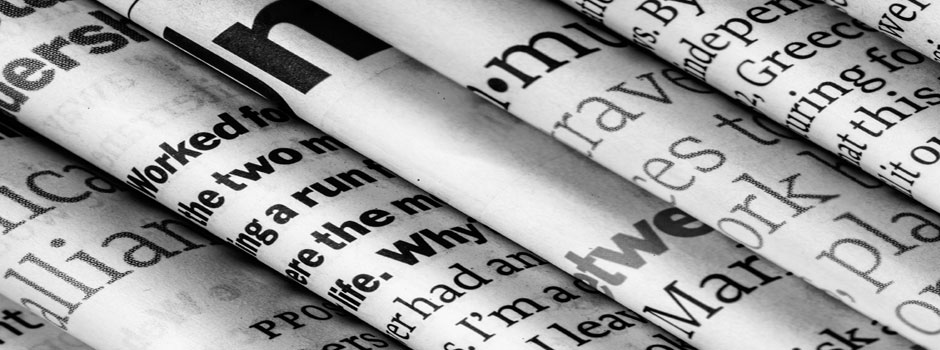A journalist responsible for the page layout is less a painter and more an interior designer. They work their magic within the rectangular frame imposed by the page format. They carry out the necessary technical operations, arranging the main and secondary elements so as to create the best visual effect.
THIS MEANS STRIKING THE RIGHT BALANCE, ON TWO LEVELS.
A general balance, on the page, between black and white: between the white of the paper and the black of the print. If there is too much white, there is not enough to read. If there is too much black, the articles are too compact and become difficult to read. Compact ratio: 3/4 black, 1/4 white. Ideal ratio: 2/3 black, 1/3 white. Artistic ratio: 3/8 white, 5/8 black.
A specific balance, within the black print, between the main motif and the secondary ones, on the one hand, and between the various secondary motifs, on the other. The prominence of the main motif must not dwarf or eclipse the other motifs.
The page architect solves this issue by looking at:
- the page margins around the printed text,
- the number and width of the columns on the page.
- the fonts available for the texts,
- the size and weight of the characters used for each article and headline,
- the length of the lines,
- the spaces between words, lines and columns.
The page architect creates draftsusing mock-ups. They have a range of these available, or can create a customised one. When it comes to the layout, there are traditions, customs, habits, but no absolute rules, apart from common sense and good taste.
SHOWCASING THE MAIN STORY.
The main point of interest of each page, its highlight, its focus, is the main story. Each page has only one main story. It gets the most prestigious placement: at the top the page. It has the biggest headline. Its format, the size of its headline and any images it has dictate the distribution of the other stories on the page. But the prominence of the main motif must not dwarf or eclipse the other articles, which are, individually, also very important. The page architect works to find the best arrangement: They consider the proportions and how they will fit within a set frame.
FINDING PROPORTIONS THAT WORK TOGETHER.
The knowledge of how to best balance the individual parts both among themselves and as a whole is as old as painting or music. The architectural art of page layout draws its inspiration from the harmonious proportions used in the other arts.
Typographic harmony avoids the effects of symmetry by using the 4-2-1 rule: when the main story has a headline that spans four columns at the top of the page, standard practice dictates that there should not be any other headlines on that page with three-column headlines, as this could detract from the main story. There can, however, be several one- or two-column headlines in the main body of the page.
Typographic harmony prevents visual fog by using the 6-3-2 rule: when the main story has a headline that spans six columns at the top of the page, standard practice dictates that there should only be one story on that page with a three-column headline, preferably centred at the bottom of the page, while there can also be several two-column headlines in the main body of the page.
THE GOLDEN RATIO.
The best way to achieve harmonious proportions when creating the layout is to split the page into four spaces using the ancient Golden Ratio (rounded to 1.618). This ensures that the spaces are “in the extreme and mean ratio”, to use the words of Greek mathematician, Euclid.
The arithmetic is easy, whatever the page dimensions (see annex):
Divide the width (W) of the page by the Golden Ratio:
Page width ÷ 1.618 = x
Subtract the result from the width (W):
Page width – x = y
Measure the “y” value along the width at the top of the rectangle (AB), preferably working from the upper right corner (B) of the rectangle.
This “y” value marks the position of Point P1 along the width (AB) of the rectangle.
Using this Point P1, draw a vertical linedividing the page into parts that are unequal but in the “Golden Ratio” proportion.
Do the same with the height (H) of the page to divide the page horizontally at Point P2, measured from the bottom right corner (C) of the rectangle.
The page is now split into four different rectangles that form a harmoniously proportioned whole that exudes simplicity, clarity and diversity.
Each of these four areas can, if needed, be subdivided using the same formula. This ideal grid can be adjusted in several ways, vertically or horizontally, to account for “staircase” breaks in the columns and the positioning of articles that straddle two areas.
REMEMBER:
- Choose the font carefullyKeep things simple: too much typographic diversity will tire the reader. Stick to two fonts: a serif font, such as Times, for texts, and a sans-serif font, such as Helvetica, for headings and subheaders. Play with roman, bold and italicised text depending on your genre.
- Be careful with your lead paragraphsThe lead paragraph is not the start of the article. It’s a short preface to introduce your article and invite the reader to keep reading.
- Watch out for jumpsYou can’t stop your text just anywhere, and especially not in the middle of a sentence, even on the front page, if the rest of your text is several page into the newspaper. You must not let jumps affect reading ease and fluidity.
Newsroom teams that are able to draw up precise schemas and stick to them are better off managing the designs of their mock-ups directly and sending them to the editorial office for verification and implementation.

